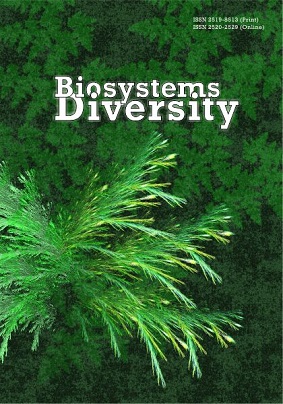Предотлетное скопление японского (Grus japonensis), даурского (G. vipio) и черного (G. monacha) журавлей в 1992 г. на территории Муравьевского парка устойчивого природопользования
Pre-migratory congregations of Red-crowned (Grus japonensis), White-naped (G. vipio) and Hooded (G. monacha) cranes in the Muraviovka Park for Sustainable Land Use in 1992
Author(s): A. V. Matsyura, P. I. GorlovSubject(s): Sociobiology, Transformation Period (1990 - 2010)
Published by: Дніпропетровський національний університет імені Олеся Гончара
Keywords: autumn pre-migration gatherings; number of birds in a flock; breeding season; birds’ behaviour;
Summary/Abstract: The autumn pre-migratory concentrations of Red-crowned, White-naped and Hooded Cranes were studied in the Muraviovka Park for Sustainable Land Use and Environmental Education (Tambov District, Amur Region, Russian Federation) during 23.08–29.09.1992. We counted 292 Hooded Cranes, 34 White-naped Cranes, and 17 Red-crowned Cranes during the study period. We also marked specific differences in the behaviour of the birds connected with their readiness for migration. The Hooded Cranes showed the greatest readiness for migration. We observed mutual flights, overnight stays, and feeding of adult birds and family groups in their flocks. This was not the same in the flocks of Whitenaped Cranes. However, the average number of birds in the flocks of White-naped Cranes had increased by the end of our observations due to new families joining the general flock. The family parties of the Red-crowned Crane and adult birds without young individuals stayed apart from each other and from other crane species during the whole observation period. We registered the autumn departure of Hooded Cranes in late September, the migratory departure of White-naped Cranes in the middle of October, and the Red-crowned Cranes left the area in the first half of November. The breeding period for all crane species starts at the same time: the third decade of April – the beginning of May. The young of the studied crane species differ significantly in the period of time before fledging: Hooded Cranes – 55–60 days, White-naped Cranes – 65– 70 days, and Red-crowned Cranes – 70–75 days because of their specific differences in the ratio of size to weight (1 : 1.3 : 1.7). Thus, the time difference between the Hooded and Red-crowned Cranes is about 2–3 weeks. We suggest that this is the main reason that determines the differences between these species in the timing of the start of autumn migration.
Journal: Biosystems Diversity
- Issue Year: 25/2017
- Issue No: 2
- Page Range: 132-140
- Page Count: 9
- Language: Russian

